|
This article first appeared in a previous edition of Equestrian Life magazine. To see what is in our latest digital issue, please click here.
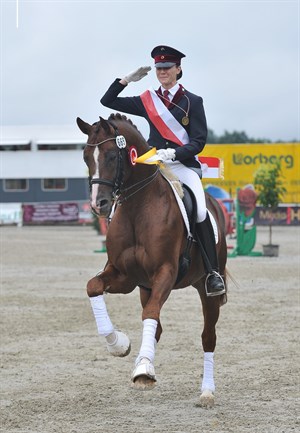
Quaterback
© Björn Schroeder
While the tempests of German history have kept Neustadt-Dosse in the shadows of more well-known German breeding centres such as Celle or Warendorf, in the years since German reunification in 1990, horses such as Poetin, Quaterback and Belantis have turned heads worldwide and raised the profile of this “sleepy hollow” in the Brandenburg countryside.
BY MICHAEL HOFFMANN
LOCATED ON NEARLY 500 hectares of prime meadows and grasslands, the State and Main Stud at Neustadt on the Dosse lies about an hour’s drive from the German capital Berlin. Its heritage-protected buildings were built in the Neo-Classicist style, resembling French or German chateaux, hence the nickname “Sanssouci” in reference to the famous palace of Frederick the Great in nearby Potsdam.
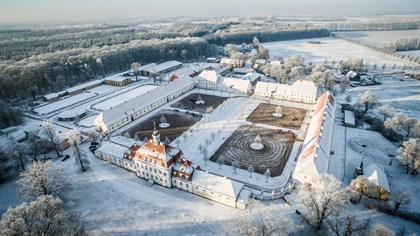
Pride of place for the “Landstallmeisterhaus”, the chateau-like mansion of the stud master.
© Juliet-Whiskey Luftbilder Brandenburg
The story begins in 1662 when Count Frederick II von Hessen-Homburg drained several hundred hectares of marshy swampland north-west of Berlin. His goal was to breed horses and sell them profitably to the Prussian dukes and kings. A century later the area came into the hands of these Prussian kings. One of these, the aesthete Frederick William II, a lover of beautiful women and horses, despaired in his inability to find noble horses among the “sand nags” coming from the Brandenburg countryside. They were unsuitable and didn’t meet the requirements of the Prussian army. Consequently, horses had to be purchased at a great cost from abroad – England, Holstein, France – and the travel ordeal often left them worse for wear.
So in 1788, the king decreed the creation of a stud at the small town of Neustadt on the river Dosse, and even passed a special law, “To The Benefit Of The Land”, outlining that excellent horses were to be produced to aid the industry, the farmers, and to let his military compete with the best that other states could muster.
A 3000km journey to Aleppo in Syria resulted in the purchase of 13 Arabian stallions. However, seven of them soon died and most of the others didn’t turn out to be great sires. The exceptions were the golden-bay Arab cross Turkmainatti, as well as Mocraby and Bayan.
Bayan’s son Pretender was purchased by none other than Napoleon Bonaparte, who named him Sanspareille (Without Equal). Napoleon also dealt the fledgling stud a disastrous blow. Overrunning Europe, he annihilated the Prussian armies and conquered the kingdom. The Neustadt stud fell into the hands of the French army and any attempt at evacuating the most valuable stallions came too late. Turkmainatti vanished without a trace.
Only the end of the Napoleonic Wars in 1815 allowed for a new beginning. However, the driver was a new fashion coming from England: Thoroughbred racing. English Thoroughbreds came to dominate the breeding at Neustadt. Boom and bust for quick profits replaced the original long-term approach planning over generations of horses. Predictably, when the racing fad ended, the narrow and fine-boned horses proved to be totally unsuitable for agriculture, industry and military. Unable to stem its losses, the stud was dissolved in 1876.
The Kaiser himself, Wilhelm II, brought the place back to life around 1894. With the same brash and unerring foresight that would lead Germany to catastrophe, he declared: “The automobile is a passing fad, I believe in the horse!” His majesty’s love of pomp and circumstance required proper cavalry horses that looked great on parade. Yet, the cavalry paid a high price; on the German side alone 1.5 million horses marched into World War I, one million of them perished.
During the Hitler era, Neustadt became a branch of the notorious Stormtroopers of the SA and was tasked with training cavalry for the war. Military orders demanded a “broad-chested Warmblood horse which can achieve 70-150km per day when ridden in trot” and the Nazi army heavily relied on horses to transport supplies. Three million of them took part in World War II; sadly two-thirds died, nearly 900 per day. With German defeat imminent and the Red Army advancing, once again a futile effort was made to evacuate the most valuable Neustadt horses towards the West, but roads and river crossings were too clogged with desperate military units and panicked civilians. The Soviets plundered the stud as reparations. With the exception of one lame 18-year old stallion, every single horse was loaded on train wagons and transported east, to the horror of the staff that had to witness the pitiful and frantic whinnies and cries of separated mares and foals.
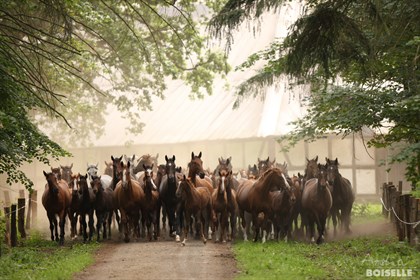
Mares and foals in front of the Glasewald barn.
© Archiv Boiselle
In a country that had reaped the whirlwind for the wind it had sown, once again the stud had to start from nothing. Feeding the population was the primary goal, so breeding horses to pull ploughshares in these twilight years of pre-motorised agriculture was extremely important under the aegis of the East German Communist party. To secure income and food production the stud also raised pigs, cattle, and for a while, even mushrooms!
Fortunately the high quality of breeding in the surrounding countryside with good access to excellent stallions paid off, allowing Neustadt to replenish its stocks without a decline in the bloodlines. They also retained and attracted talented riders who formed the core of new trainers and competition riders in the German Democratic Republic. This went hand in hand with the shift of the horse’s use from agriculture to sport and leisure. One of these talents was Christel Granzow, who became the first dressage champion of the GDR on the Neustadt stallion, Aladin. Their career was cut short when the party leaders traded the horse to the UK in exchange for a valuable prized boar.
Desperate for Western currency, this approach became the norm during the existence of the Eastern German state. The Brandenburg breed from Neustadt and surrounds were a means to an end for the Communist party to raise funds and stave off the collapse of the system. Dr Jürgen Müller, one of the former stud directors, estimated that close to 500 million deutschmark flowed into the state coffers from the sale of horses. Most went to West German owners keen to acquire top quality horses for significantly less than a comparable horse would cost at any of the Westphalian, Hanoverian or Holsteiner studs.
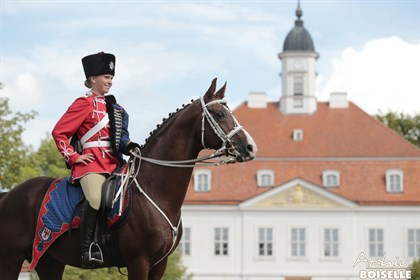
A rider in the historic Prussian uniform.
© Archiv Boiselle
When the Wall finally fell and Germany was reunified in 1990, the headlong rush towards capitalism turned into the other extreme and the suddenly unprofitable stud had to hold fire sales where horses with excellent breeding lines were dumped en masse, mostly to the West German areas. Small riding schools suddenly found themselves able to afford amazing breeding lines that went back decades if not centuries.
The injection of government funds halted the sell-off as did the creation of an organisation to preserve and continue the Brandenburg breed. With the foresight and skill of a number of stud masters, among them Heinz Hoppe and Jürgen Müller, a new generation of horses emerged. Bringing in stallions such as Sandro Hit and Quando-Quando (who represented Australia at the 2009 Olympic Games in Beijing and became one of Kristy Oatley's most successful Grand Prix horses) laid the foundation for a new label, the Deutsches Sportpferd (German Sport Horse), whilst maintaining the famous “arrow and serpent” branding of the past.
In 2000 a mare of the Neustadt P-family, Poesie, never herself an outstanding competition horse but beloved for her temperament and attitude, gave birth to a foal, a filly named Poetin. Described as a “horse that appears every hundred years”, as “beautiful and she knew it”, she caused a sensation when she won the Bundeschampionat in 2006 and was sold for a then-record sum of 2.4 million euro to a Dutch dressage stable. Tragically she died only two years later of laminitis, yet she truly established Neustadt’s claim to breeding internationally competitive horses.
Poesie is also the grandmother of a Quaterback, a horse whose name has put Neustadt on the radar as far away as the United States and Australia. He is an outstanding sire who is passing on his exceptional movement and temperament throughout the world.
With that the floodgates of head-turning stallions seemed to have opened. Quaterback sired the stunning black stallion Quadroneur, who caused a sensation with his phenomenal performance at Spruce Meadows in Canada. He is busy producing an outstanding crop of foals that seem to inherit their sire’s breathtaking looks. Another addition is the beautiful Belantis, a grey described at his stallion licensing as “very elastic, with lots of springiness and always with an uphill movement”. Ridden by Beatrice Buchwald, under the guidance of Isabell Werth, he won the Bundeschampionat of five-year-old dressage horses in 2014 and was reserve champion at the World Championship for Young Dressage Horses in 2015.
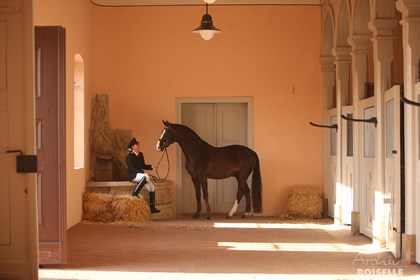
The beautiful historic stallion barn.
© Archiv Boiselle
The attraction of the Brandenburg horses lies in their combination of new-school looks with old-school temperament. Big moves are combined with the original virtues of “Rittigkeit” (rideability) and temperament, in short horses that can be ridden by competitive and sport riders alike.
These days Neustadt-Dosse is also famous for a range of annual events, such as foal shows, stallion parades, licensings and competitions that are attracting up to 15,000 visitors each. It is also a well-respected provider of training courses in all disciplines, and there’s even a stable with well-educated school horses if you can’t bring your own. There’s the only German comprehensive school offering equestrian sports as a major subject, and the historic grounds are open for equestrian holidays, guided tours and weddings. So, if you plan a visit to Germany, make sure to include a trip to Brandenburg and the famous equine Sanssouci.
READ THE LATEST NEWS ARTICLES HERE

|

